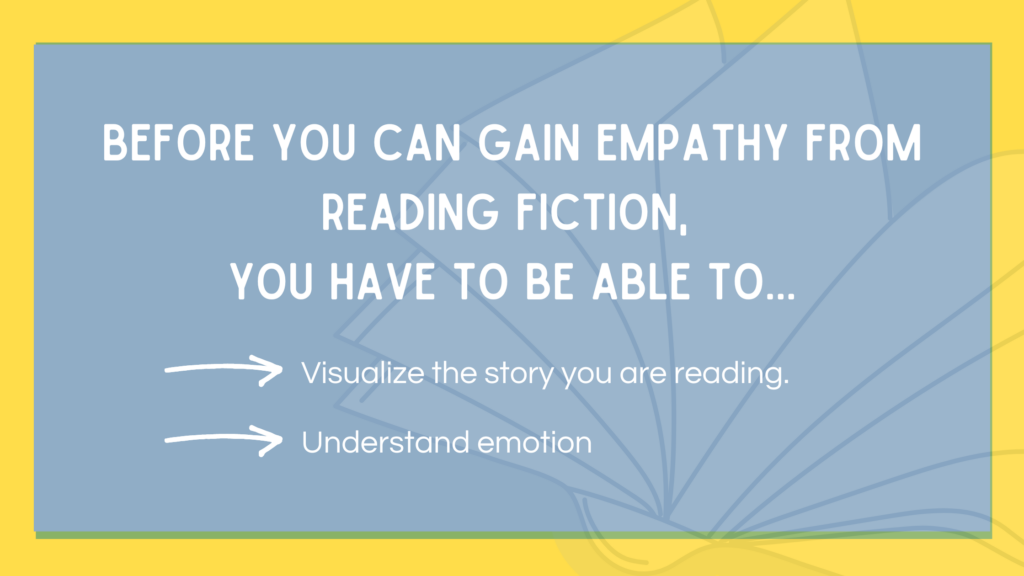How to Gain Empathy Through Reading Fiction
August 6, 2022
Here’s how you can put the research into action in your own home and ensure your children really do gain empathy from reading fiction.

Maybe you’ve heard that research suggests that transportation into the story world when reading fiction promotes empathy and prosocial behavior. You want your child to gain empathy through reading fiction! But is simple reading enough? How can we help our children transport themselves into the story world? Here are two key ways to help get your child into the story world and, consequently, become a more empathic person.
1) VISUALIZE THE STORY WORLD
(BONUS: THIS AIDS COMPREHENSION)
To feel transported into the story world, a reader needs to visualize the world in their mind’s eye. What does every detail look, feel, smell, and sound like?
SOMETHING TO TRY:
Have your child draw a freeze-frame of a scene in the novel they are reading. Suggest an actual drawing first, but if this feels too stressful, a Google image search to create a collage of images is a good alternative. Make sure they don’t select just one single image! The search and curation process helps the critical thinking process!
WHAT ELSE THIS DOES:
This exercise forces your child (or you!) to slow down and really consider the environment of the story world, which will help them be able to visualize the characters moving through it.
IF YOUR CHILD IS STRUGGLING WITH COMPREHENSION, try doing this together for a familiar novel or story. As always, I encourage you to do this alongside your child.
QUESTIONS TO ASK AS/BEFORE THEY GET STARTED:
- What colors are you going to use?
- Which details from the text do you really want to include?
- Example: there is mention of a certain family photo or type of chair.
- Which details do YOU notice in your mind when reading that the author doesn’t explicitly mention in the text?
- Example: “I think her room would never have a messy floor; she always wants to please her parents.”
IF THEY STRUGGLE:
- “List some of the details in your own bedroom/classroom/friend’s house/grocery store/etc. you would include in a picture of it.”
QUESTIONS TO ASK WHEN THEY FINISH:
- Most importantly: “Tell me about this scene.”
- The open-ended question allows them to explain what they drew and avoids you asking questions about things that are obvious to them!
- “Tell me why you chose to draw ____ in this way?”
- “Why would this ____ be this color?”
- “Is there anything you weren’t able to draw that you visualize?”
- “Is there anything you’d like to add (you don’t have to actually draw it!) after talking about it a little bit?”
SHORT ON TIME OR FEEL LIKE THIS WOULD BE TOO MUCH FOR YOUR FAMILY?
Try asking your child to simply describe a scene in their book – as if they were creating an image – the next time you’re walking or driving somewhere. The same kinds of questions apply!
HOW DOES THIS EXERCISE HELP DEVELOP EMPATHY?
OK, so, it’s impossible to even begin to understand someone’s emotions if you don’t understand the environment they’re in. In order to fully transport ourselves into the story world, we have to be able to envision what it would be like to be a character in that world, and visualizing the physical details help us get there. We have to be able to understand what it would be like to be in the space in the story in order for a novel or short story’s magic (but really, it’s science!) allow us to gain empathy through reading fiction.
2) UNDERSTAND + NAME EMOTIONS
Visualizing the story world is the first step to transporting yourself into it; understanding the characters’ emotions comes next. But if we don’t know anything about emotions, this is going to be pretty challenging!
I’m a big fan of the feelings wheel and encourage everyone to have one close by. This feelings wheel is great because it not only provides a visual of the different layers of our emotions, but it also helps students understand nuance in word meanings.
SOMETHING TO TRY:
Instead of initially asking about how the character in your child’s book feels, I like to start with the feelings wheel. Have your child pick a character and a moment in the novel they are reading – or even in picture book or movie you are all familiar with – and then pick out a word in the circle closest to the center of the feelings wheel. Next, have them talk through details from the book as they work their way to the outer edge of the feelings wheel to find a more nuanced word to describe that character’s feelings in that moment. With younger children, especially, be prepared to define some of the words for them.
NOTE:
You know your child best. Some children (a ten-year-old or a high schooler!) may be ready/interested in trying this on their own first, and some (again, a ten-year-old or a high schooler!) may need you to walk them through this exercise with your own book or a shared story a couple of times before you ask them to do it on their own.

So, there you have it. Try these two (I have more!) simple activities to help your child enter the story world of their book and gain empathy through reading fiction. Send me an email at hello@readingandwritingmatters.com to let me know how these activities went for you and/or you have any questions!
Add a comment
0 Comments